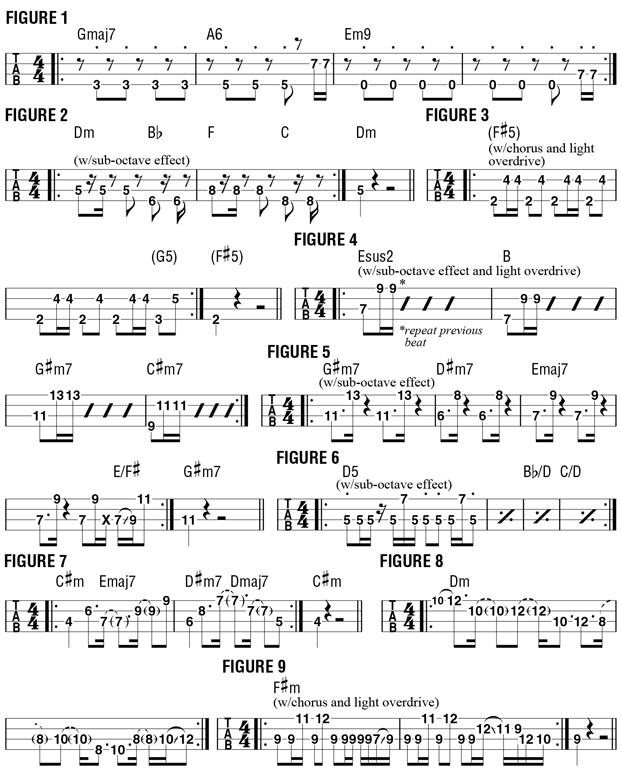Copping a Techno-Flavored Synth Bass Sound

Though I’m assuredly a rocker at heart, I’ve learned throughout my travels as a bassist that in order to stay employed, one must be adaptable, stylistically.
This often means playing genres of music that are just on the fringes of rock, such as dance and techno. Though these styles are primarily synth- and computer-based, it’s not that difficult to achieve a similar sound on a more organic instrument, such as an electric bass. From a rhythmic standpoint, rock and techno really aren’t that far apart: in each, the kick drum hits on beats one and three, or sometimes all four beats, and the snare lands on two and four.
Further, if we figure out what tonal and rhythmic characteristics are present in most electronic dance bass tracks, we can emulate them fairly convincingly with a simple bass/stomp box/amp setup. All you need after that is steady time and the ability to lay down an unrelenting groove.
To start, you’ll need a fat, bottom-heavy tone on your amp. The location on the bass where you pick the strings will also dictate your sound: closer to the bridge works great for clean, precise, staccato 16th notes, while picking near the neck will provide a dull but deep sound for grooves with long tones (we’ll explore this in a bit). To emulate a synth bass, you may opt for a few effects; I like to keep a sub-octave doubler and distortion pedal (set to relatively light gain) at the ready. These effects can be achieved through common individual stomp boxes, such as the Boss OC-3 Octave and ODB-3 Bass Overdrive pedals, or via higher-end multi-effect units.
Next, you’ll find that electronic music, like other genres, has common rhythmic themes. Once you’re familiar with them, it’s easy to create your own two- or four-bar loops, upon which harmonies and melodies can be built. The challenge is to think like a synth bass and play as precisely as possible, then just sit back and groove. FIGURES 1 and 2 are basic electronic dance-style rhythmic motifs; pick close to the bridge for extra punch, play the notes short and detached, and try to keep your attack consistent, volume-wise. (Suggested effects, if any, are indicated in the music.)
FIGURES 3 and 4 feature the “gallop” rhythm, where an eighth note is played on each downbeat, followed by two 16ths an octave higher. Again, pick near the bridge for punch and precision, try to keep your attack even, and, in the case of FIGURE 4, your position shifts seamless. FIGURE 5 depicts another common, simple rhythmic theme featuring the use of a sub-octave effect, while the challenge of FIGURE 6 lies in holding down a clean, staccato 16th-note groove without letting up on the tempo.
Electronic bass lines can also take the form of long, deep tones. In FIGURES 7 and 8, we’ll roll off the highs, boost the lows and pick closer to the neck to emulate a vintage sub-bass synth sound. We can even use grace notes and finger slides, as depicted in FIGURE 8, to simulate a synth’s pitch wheel. Finally, FIGURE 9 makes use of the Phrygian mode to create an aggressive, trance-like techno groove.
Besides paying attention to rhythm, we can also make our faux-synth bass parts more convincing by employing some finger vibrato and quick grace-note slides. In our final example, the wide vibrato at the end of the phrase emulates the pitch wheel on a synth bass.
Bass Camp July 2016 FIGURE 1
Bass Camp July 2016 FIGURE 2
Bass Camp July 2016 FIGURE 3
Bass Camp July 2016 FIGURE 4
Bass Camp July 2016 FIGURE 5
Bass Camp July 2016 FIGURE 6
Bass Camp July 2016 FIGURE 7
Bass Camp July 2016 FIGURE 8
Bass Camp July 2016 FIGURE 9

Get The Pick Newsletter
All the latest guitar news, interviews, lessons, reviews, deals and more, direct to your inbox!
“There are so many sounds to be discovered when you get away from using a pick”: Jared James Nichols shows you how to add “snap, crackle and pop” to your playing with banjo rolls and string snaps
Don't let chord inversions bamboozle you. It's simply the case of shuffling the notes around







![Joe Bonamassa [left] wears a deep blue suit and polka-dotted shirt and plays his green refin Strat; the late Irish blues legend Rory Gallagher [right] screams and inflicts some punishment on his heavily worn number one Stratocaster.](https://cdn.mos.cms.futurecdn.net/cw28h7UBcTVfTLs7p7eiLe.jpg)


![A black-and-white action shot of Sergeant Thunderhoof perform live: [from left] Mark Sayer, Dan Flitcroft, Jim Camp and Josh Gallop](https://cdn.mos.cms.futurecdn.net/am3UhJbsxAE239XRRZ8zC8.jpg)